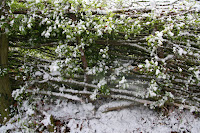

I've been watching this living fence for a year now, enjoying its responses to the changing seasons. It is layered Hawthorn, with a few Hawthorn trees left to grow on. Between the winter and summer pics above, a realisation that wooden fencing is increasingly in short supply globally has added a practical edge to my interest. Traditionally laid in winter, before the sap rises, the stems are severed with a billhook until they lean over on their own with just a small amount of tissue to keep the trees alive. Stumps and "pleachers" (the layered stems) send up new shoots which thicken and strengthen the hedge. Stakes at regular intervals and a woven layer of hazel sticks along the top ("heatherings") keep this living artwork in place - beautiful.
Perhaps not quite so obviously beautiful as living fences of rosa rugosa and some of the living fences in widespread use across central/southern America. The experience in Africa has been mixed (I have seen park managers spend years trying to reduce the invasive spread of "prickly pear" planted with all good fencing intention) but living fences are being reinvented in our carbon constrained world. There are downsides but generally living fences must be preferable to carbon-unfriendly metal & plastic n'est-ce-pas?
Back to watching the twigs grow....the screenplay for ."There will be Wood" is Future Earth's next offering to Daniel Day Lewis.
Monday, 7 July 2008
Fabulous fences
Posted by
Arjay
at
16:55
![]()
Labels: Ecosystem Services, Land use, Waste and recycling;, Wellbeing
Subscribe to:
Post Comments (Atom)
No comments:
Post a Comment